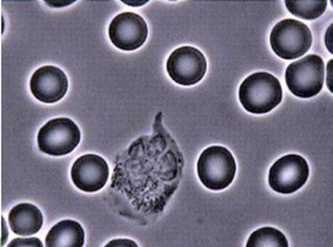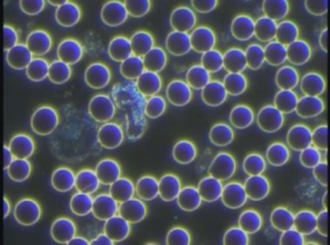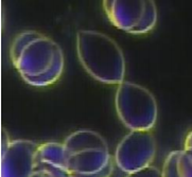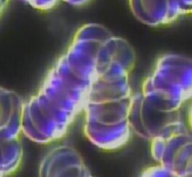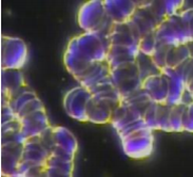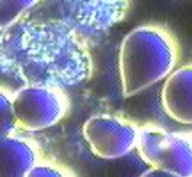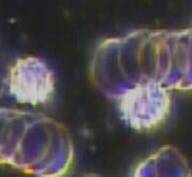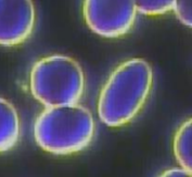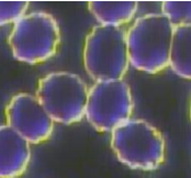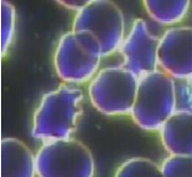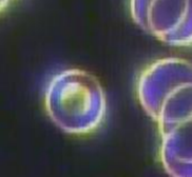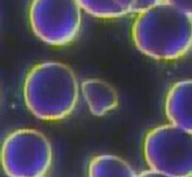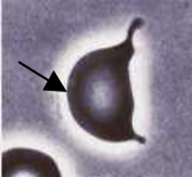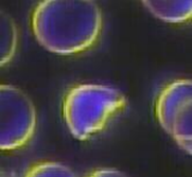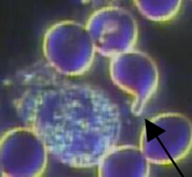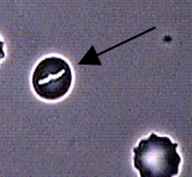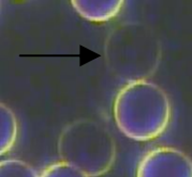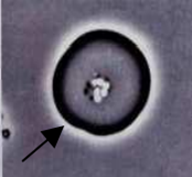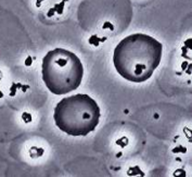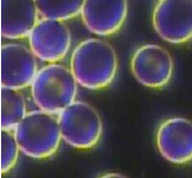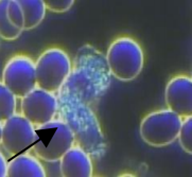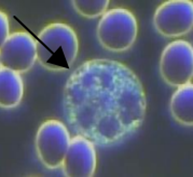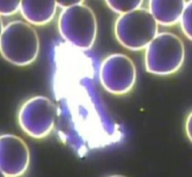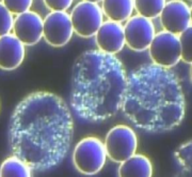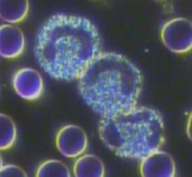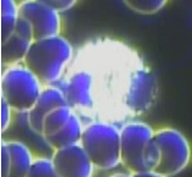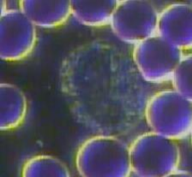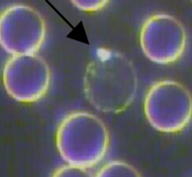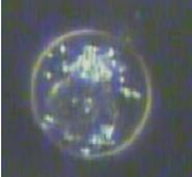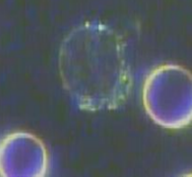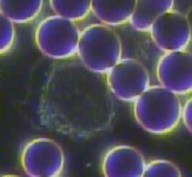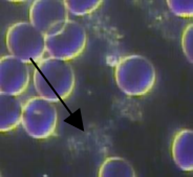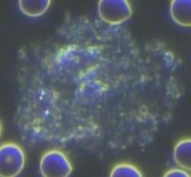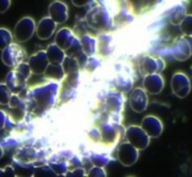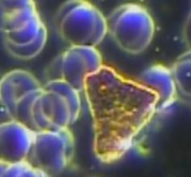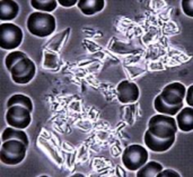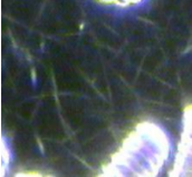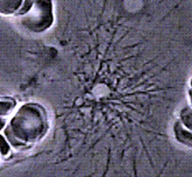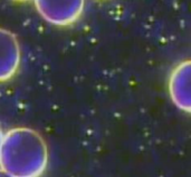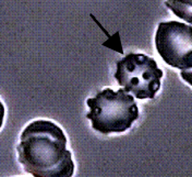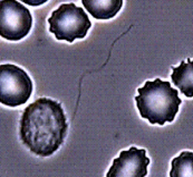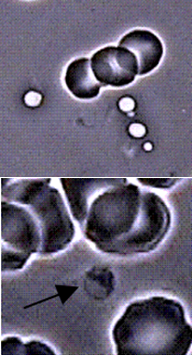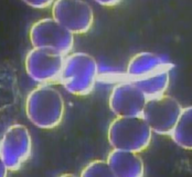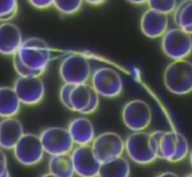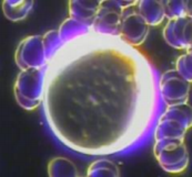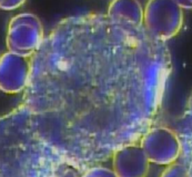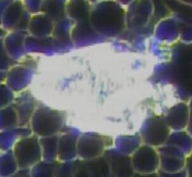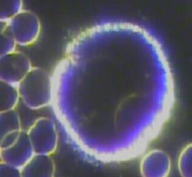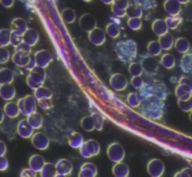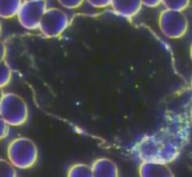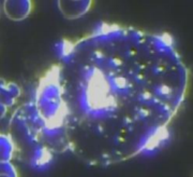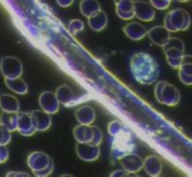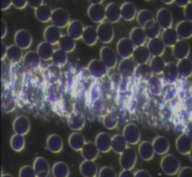Live Cell Microscopy - Examples
Example of good, healthy red blood cells and environment (following 2 x images)
|
The Red Blood Cells (Erythrocytes) are uniform in size and shape and appear as round circles on a gray background (in Phase Contrast). The center of each cell is lightened somewhat and slightly off white in color. They reside freely in their own space, not overlapping or sticking together, but gently bouncing off each other.
|
The White Blood Cells are about as large as 2 Red Blood Cells and have a rather grainy
appearance with different characteristics depending on their type. They display many different shapes and some are active and moving. In normal blood there are about 700 Red Blood Cells to every White Blood Cell. |
The Plasma surrounding the cells, is clear with some Chylomicron and Globin particles
dancing about. There is also a scattering of platelets but without much cellular breakdown, bacteria, clots, or other undesired floating masses. |
The next 3 pictures are progressively worse indications. They reflect a loss of “electrical charge” of the RBC’s which causes them to stick together. Cells find it more difficult to transfer oxygen to tissues and to circulate freely. CAUSE: Too much cooked animal protein in diet, low digestive capacity, low HCL production and enzyme utilization dehydration, diet not proper for blood type, consumption of processed foods, high sugar and/or carb, prescription/street drugs, excess alcohol intake, smoking, heavy metals. Minerals may be off. Inflammation marker. SYMPTOMS: Fatigue, lethargy, heart stress,poor circulation, BP off, possible edema, blood sugar fluctuations, hormonal imbalances, etc...
Anisocytosis Variation in RBC size
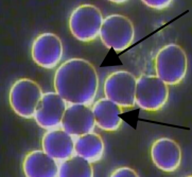
Macrocytes - Big RBC’s
CAUSE: Overall lack of good nutrition or assimilation which can lead to being low in Vitamin B12, Folic Acid, fat soluble Vitamins A & E. Can be from poor digestion & possible lack of HCL stomach acid, low bile flow from liver dysfunction, low enzyme production. This can lead to lack of friendly intestinal bacteria. SYMPTOMS: Inability of RBC’s to adequately carry oxygen – shortness of breath, fatigue, light headedness, various types of anemia.
Microcytes - Small RBC’s CAUSE: Low in Iron, B12, Folic Acid, same as above. SYMPTOMS: Anemia, low energy, tired. Bone problems, osteoporosis.
CAUSE: Overall lack of good nutrition or assimilation which can lead to being low in Vitamin B12, Folic Acid, fat soluble Vitamins A & E. Can be from poor digestion & possible lack of HCL stomach acid, low bile flow from liver dysfunction, low enzyme production. This can lead to lack of friendly intestinal bacteria. SYMPTOMS: Inability of RBC’s to adequately carry oxygen – shortness of breath, fatigue, light headedness, various types of anemia.
Microcytes - Small RBC’s CAUSE: Low in Iron, B12, Folic Acid, same as above. SYMPTOMS: Anemia, low energy, tired. Bone problems, osteoporosis.
Various Types of Poikilocytes (Variation in RBC shape)
Elliptocytes “Pencil shape”
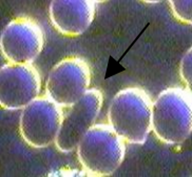
Red cells that are elliptical in shape. May range from pencil to cigar shape. CAUSE:Large numbers are most commonly seen in iron deficiency.....possibly poor iron absorption from low HCL production due to stress or strong emotions. They may also be seen in hereditary elliptocytosis.
Various Types of Schistocytes (Damaged or fragmented cell membrane)
Bite Cell
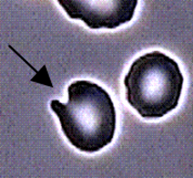
RBC’s from which denatured, precipitated masses of haemoglobin have been pitted by the spleen. The bites can range from large "bites" to tiny "nibbles". CAUSE: Prescription/street drugs, viral activity or low oxygenation.SYMPTOMS: Chronic fatigue.
Other Red Blood Cell Anomalies
White Blood Cells
Overall WBC count Normal count: There should be approximately 1 WBC for every 700 RBC. Abnormal count: NOTE: This is a perspective based on the
observation of the client’s blood. - WBC’s – FEWER than normal *This is only problematic if there are other issues going on. Make sure to take the “whole”
picture into consideration. Indicates a more catabolic state. WBC’s – MORE than normal CAUSE: Viral activity, bacterial infection, microbial infection, lack of sleep, stress (emotional, physical, environmental). Indicates a more anaoblic state. After eating, there may be an elevated WBC count typically in the following: NONE from raw organic food. MILD from stovetop or oven cooking. MODERATE from pressure cooked or canned food. SEVERE from processed foods, food additives, candy, refined carbs, sugar, soft drinks, etc…WHOPPING from processed meats & microwave cooking.
observation of the client’s blood. - WBC’s – FEWER than normal *This is only problematic if there are other issues going on. Make sure to take the “whole”
picture into consideration. Indicates a more catabolic state. WBC’s – MORE than normal CAUSE: Viral activity, bacterial infection, microbial infection, lack of sleep, stress (emotional, physical, environmental). Indicates a more anaoblic state. After eating, there may be an elevated WBC count typically in the following: NONE from raw organic food. MILD from stovetop or oven cooking. MODERATE from pressure cooked or canned food. SEVERE from processed foods, food additives, candy, refined carbs, sugar, soft drinks, etc…WHOPPING from processed meats & microwave cooking.
Live blood video showing a white blood cell (neutrophil) chasing bacteria
You will observe this type of activity (on the big screen) when we look at your blood!
AGRANULOCYTES
Plasma Observations
Pteroharpen “Spreading Platelets”
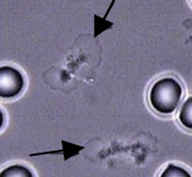
When platelets are out of the body and put on a slide with a cover slip, the membrane may undergo spontaneous spreading. The area that is spreading is called the Hyaloplasmic Veil. This is a shadowy form, often behind and surrounding the platelets like a haze that make it appear as if the platelets have butterfly wings. CAUSE:This phenomenon is still a mystery but many belief systems associate it with pH imbalance, low oxygenation, leaky gut syndrome (internal toxicity), low friendly intestinal bacteria, antibiotic therapy, high blood sugar, excess dietary PUFA’s or carbohydrates. May also be related to undigested protein in the blood. High amounts of animal protein from cooked animal food sources (or even undigested protein from vegetable sources) in the diet is a common profile. They can signify strong circulatory hindrance. SYMPTOMS: Fatigue.
CRYSTAL FORMATIONS
BLOOD PROTEINS
Three blood proteins are albumin, globulin and fibrinogen. A high albumin/globulin or A/G ratio is a sign of good health. We cannot see these proteins in the blood, but we can see fibrinogen when it begins to activate and turn to fibrin. Seeing fibrin strands develop in your picture, depending on speed and intensity, is a sign the blood might be a bit thick and this could be stressful for the liver and cardiovascular system in general.
Clotting Fibrins
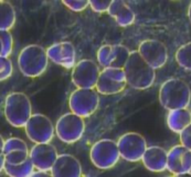
Appears as long strands mixed with thicker blood protein elements. Early signs of clot formations causing thicker blood. CAUSE: Stress, poor protein digestion, incompatible protein for blood type. Liver stress, poor bowel elimination, etc….See Fibrinogen strands for other causes. SYMPTOMS: Poor blood circulation, fatigue, constipation, etc…
OTHER BLOOD ELEMENTS
Symplasts
Granular looking chunks with a hard outer shell. Resembles “rock formations” and may appear reflective in Darkfield Microscopy. This is a merge of plasma colloids and particles due to a change in electrical charge once the blood is out of the body and onto the slide. Can cause hardening of the blood vessels and slows down the blood flow. They vary in color and size and are densely packed with toxins and microorganisms. Grey ones tend to show more “protein” issues and white ones tend to show more calcification and plaque issues. When they appear as very dark brown or “black” it is a sign of high toxicity from chemicals in our food and the environment. They may contain the following toxic substances that have adhered to each other: lipid core, fibrin deposits, thrombocyte aggregation, calcification, proteins, lipids, cellular debris and collagen (calcium imbalance). CAUSE:Poor circulation, high cholesterol, mineral imbalance, digestive insufficiencies (low HCL and enzyme production), etc… SYMPTOMS:Pain in calves, cold hands & feet, low energy toxicity, skin disorders, frequent and recurring colds, flu and infection, and possible tooth decay, etc… Commonly seen when the individual is undergoing amalgam removal. It is also commonly seen in someone who is recovering from, or was recently infected by viral forms.
Symplast Shapes
NOTE: The following shapes may appear on their own or stuck to other blood elements. Square: Neurological problems and immune disorders. SYMPTOMS: Nervousness, highly strung, irritability, hyperactivity, depression, listlessness, aimlessness, headaches and migraines.• Trapezoidal: Caused by poor digestion of fats. Circular: Immune system inactive and/or deficient, poor elimination of toxins.
